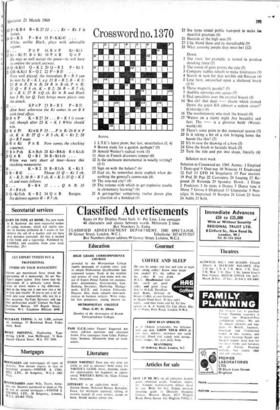Chess no. 431
PHILIDOR
Black White
P. Monreal and J. P. Boyer (second prize. Ring Tourney 1967). White to play and mate in tau moves; solution next week.
Solution to no. 430 (Boudantzev): Kt - Q 2, threat Q- Kt 5 or R x P. 1 . . . K - Q 4 ch: 2 R - K 4 (set Q - Kt 5). 1 . . . K - B 4 ch;
2 R - K 6 (set R x P). 1 R x Kt; 2 R x P. 1 . . . B x Kt; 2 Q - Kt 5. Attractive problem with the set mates against K flights transferred after the key.
The following entertaining game was played in the French universities championships. It contains a minor curiosity—four checks on consecutive moves; White's and Black's twenty-seventh and twenty-eight moves all give check, very unusual in play..In composed positions it is another matter; the following (admittedly improbable) position by G. Leathem—given rank by rank, starting at Black's QR1: K2kn2r/NP I P I PPP/1PPPnNq 11 112r1BblQ/4R3/24—has a nightmare series of twenty-eight consecutive checks (starting P- B 7 ch, Kt x P ch; 2 P x Kt ch, Kt x P ch; 3 P x Kt ch, K x P ch) can be given. But that way madness lies:
White, Baudry. Black, Villeneuve. Opening, French Defence. (Paris 1969.) 1 P-K 4 P-K 3 2 P-Q4 P-Q4 3 Kt-Q2 Kt-KB3 4 P-K 5 KKt-Q2 5 P-KB4 P-Q B4 6 P-B 3 Kt-QB3 7 Kt K 2 . . . with the idea of fan-
chettoing the K B and meanwhile securing the centre firmly. 1 prefer the more old-fashioned lines with B - Q 3 and Kt - Kt 2.
Q-Kt 3 8 Kt-B3 P xP 9 P x P B-Kt5ch10 K-B2
intending to put K B on R 3 and K on Kt 2.
10 . . . P - B 3 11 B - K 3 0 - 0
12 P-K Kt 3 Q - Q 1? Here Black should pia.% 12 . . Px P! (a) 13 Q P x P, B - B 4.t; 14 BXB Kt X B with a good game (b) 13 B P X P• Kt(2) P; 14 P x Kt, R x Kt ch!; 15 K X 1? Kt X P ch and now (i) 16 K - B 2, Kt - Kt 5 ch (ii) 16 K - Kt 2, Q x B (iii) 16 K - B 4' • P - Kt 4 ch!: 17 K x Kt; B - Q 3 ch: 18 K - B 6, Q - Q 1 mate! (c) 13 Kt X P. 10(2) X Kt; 14 P x Kt, B- B 4; 15 B X B. Q X B ch; 16 K - Kt 2, Kt X P.' and if 17 P x Kt? then 17 ... R - B 7 cid; 18 K - R 3.
Q - K 6; 19 Q - B I. Q - K B 6 winning or 19 Kt - B 4, R x Kt. If this analysis is correct then White's opening plan will not do; but t refute it Black must play vigorously and not, as here, passively. 13 p-KR 4 B-K 2? 13 . . Kt - Kt 3 is better.
14 B - R 3 P - B 4 15 P-KKt4! . . . White, unlike Black, plays with admirable vigour.
15 . • • P x P 16 B x P Kt-Kt3 17 Kt-Kt 5! BxKt 18 PXB QxP He may as well accept the pawn—he will have to endure the attack anyway.
19 Q-KKt 1 Q - K 2 20 Q - R 2 P - Kt 3 21 QR-KKt1 B - Q 2 22 P - B 5! . . . Very well played; the immediate B - R 5 can be met by B - K 1, e.g. 22 B - R 5, B - K I;
23 B X P, B X B; 24 R X B ch, P X R; 25 Q - R 8 ch, K - B 2; 26 R - R 7 ch, K- K 1; 27 R XQ ch, Kt X R and Black has 2 Rs for Q. Text brings more pieces into the attack.
22 KP x P 23 B - R 5 P - B 5! Also best; otherwise the Kt comes in on B 4 with fatal effect.
24BxP K-B2? 24 . . B - K I is essen- tial, though after 25 K - K 1 White should win.
15 R X P! Kt x K P 25 . . . P x R; 26 B X P ch, K x B; 27 Q - R 5 ch, K - Kt 2; 28 Q- R 7 mate. 26 B x Kt P x R Now comes the checking sequence.
27 B x Pch K x Bch 28 Kt-B4ch R x Ktch 29 Q x R Q-B 1 30 R-Ktich White was very short of time—hence this checking manoeuvre.
K - R 2 31 R-R 1 ch K - Kt 3
32 B - B 6! . . . Threat 33 Q - Kt 5 ch, K - K 2; 34 R - R 7 ch, K - K 1; 35 Q - K 5 ch and mate follows.
32 . . . B-B4 32 . . . Q X B; 33 R-R6ch.
33 Q-Kt5ch K- B 2 34 Q x B Resigns No defence against R - R 7 ch.











































 Previous page
Previous page